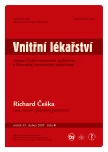CRP – a marker of a pro-inflammatory state and cardiovascular risk
Authors:
R. Poledne; Z. Valenta; J. Piťha
Authors‘ workplace:
Laboratoř pro výzkum aterosklerózy, Pracoviště experimentální medicíny IKEM Praha, přednosta doc. MUDr. Luděk Červenka, CSc.
Published in:
Vnitř Lék 2007; 53(4): 391-395
Category:
Reviews
Overview
The importance of elevated basal levels C-reactive protein (CRP) measured by a highly sensitive test has been known for over 10 years. Increased hsCRP concentration correlates with most of the classical risk factors in cardiovascular disease, however. This seriously complicates the interpretation of the elevated concentration. Concentrations of hsCRP are partly genetically determined and can easily be affected positively by lifestyle changes. These two factors lead us to conclude that the setting of hsCRP should not be used routinely at present in assessing the individual risk of complications for atherosclerosis.
Key words:
cardiovascular disease – risk factors – pro-inflammatory state
Sources
1. Dvořáková A, Poledne R. Zánětlivé mechanizmy ve vzniku a progresi aterosklerózy. ČLČ 2003; 142 : 70-74.
2. Dvořákova A, Poledne R. The incidence of infectious disease and changes in the mortality of atherosclerosis-related complications in the Czech population over the past two decades. Eur J Epid 2004; 19 : 707-710.
3. Hubáček JA, Piťha J, Škodová Z et al. C(-260)→T polymorphysm in the promoter of the CD14 monocyte receptor gene as a risk factor for myocyrdial infarction. Circulation 1999; 99 : 3218-3220.
4. Ridker PM, Cushman M, Stampfer MJ et al. Inflammation, aspirin, and the risk of cardiovascular disease in apparently healthy men. N Engl J Med 1997; 336 : 973-979.
5. Ridker PM, Cushman M, Stampfer MJ et al. Plasma concentration of C-reactive protein and risk of developing peripheral vascular disease. Circulation 1998; 97 : 425-428.
6. Rao M, Jaber BL, Balakrishnan VS. Inflammatory biomarkers and cardiovascular risk: association or cause and effect? Semin Dial 2006; 2 : 129-135.
7. Volanakis JE. Human C-reactive protein: expression, structure, and function. Mol Immunol 2001; 38 : 189-197.
8. Ridker PM, Hennekens CH, Buring JE et al. C-reactive protein and other markers of inflammation in the prediction of cardiovascular disease in women. N Engl J Med 2000; 342 : 836-843.
9. Koenig W, Sund M, Frohlich M et al. C-reactive protein, a sensitive marker of inflammation, predicts future risk of coronary heart disease in initially healthy middle‑aged men - results from the MONICA (Monitoring Trends and Determinants in Cardiovascular Disease) Augsburg cohort study, 1984 to 1992. Circulation 1999; 99 : 237-242.
10. Castell JV, Gomez-Lechon MJ, David M et al. Interleukin-6 is the major regulator of acute phase protein synthesis in adult human hepatocytes. FEBS Lett 1989; 242 : 237-239.
11. Dvořáková-Lorenzová A, Suchánek P, Havel PJ et al. The Decrease in C-reactive protein concentration after moderate weight reduction is associated with changes in plasma lipids, but not interleukin-6 or adiponectin. Metabolism 2006; 55 : 359-365.
12. Rosenson RS, Koenig W. Utility of inflammatory markers in the management of coronary Artery disease. Am J Cardiol 2003; 92 : 10i-18i.
13. Retterstol L, Eikvar L, Berg K. A twin study of C-reactive protein compared to other risk factors for coronary heart disease. Atherosclerosis 2003; 169 : 279-282.
14. Festa A, D’Agostino RJ, Howard G et al. Chronic subclinical inflammation as part of the insulin resistance syndrome: the Insulin Resistance Atherosclerosis Study (IRAS). Circulation 2000; 102 : 42-47.
15. Tintera J, Harantová P, Suchánek P et al. Quantification of intra-abdominal fat during controlled weight reduction: assessment using the water-suppressed breath-hold MRI technique. Physiol Res 2004; 53 : 229-234.
16. Staněk V, Lorenzová A, Cífková R et al. The changing spektrum of risk factors for coronary heart disease. Cor Vasa 2007 (v tisku).
17. Ranjit N, Diez-Roux AV, Shea S et al. Psychosocial factors and inflammation in the multiethnic study of atherosclerosis. Arch Intern Med 2007; 167 : 174-181.
18. de Maat MPM, Trion A C-reactive protein as a risk factor versus risk marker. Curr Opin Lipidol 2004; 15 : 651-657.
19. Paul A, Yeh ETH, Chan L A proatherogenic role for C-reactive protein in vivo. Curr Opin Lipidol 2005; 16 : 512-517.
20. Trion A, de Maat MP, Jukema JW et al. No effect of C-reactive protein on early atherosclerosis development in apolipoprotein E*3-leiden/human C-reactive protein transgenic mice. Arterioscler Thromb Vasc Biol 2005; 25 : 1635-1640.
21. Ballantyne CHM, Nambi V Markers of inflammation and their clinical significance. Atherosclerosis Suppl 2005; 6 : 21-29.
22. de Ferranti SD, Rifai N C-reactive protein: a nontraditional serum marker of cardiovascular risk. Cardiovascular Patology 2007; 16 : 14-21.
23. Danesh J, Wheeler JG, Hirschfield GM et al. C-reactive protein and other circulating markers of inflammation in the prediction of coronary heart disease. N Engl J Med 2004; 350 : 1387-1397.
24. Reifenberg K, Lehr HA, Baskal D et al. Role of C-reactive protein in atherogenesis: Can the apolipoprotein E knockout mouse provide the answer? Arterioscler Thromb Vasc Biol 2005; 5 : 1641-1646.
Labels
Diabetology Endocrinology Internal medicineArticle was published in
Internal Medicine

2007 Issue 4
Most read in this issue
- Lipoprotein (a)
- How corticoids, growth hormone and oestrogens influence lipids and atherosclerosis
- Side effects of pharmacotherapy on lipid levels
- Can reduction in resting heart rate be beneficial for patients?
